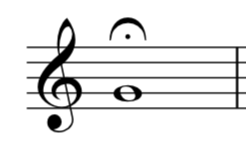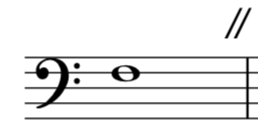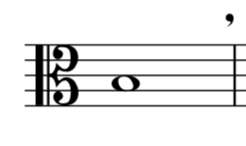Fundamentals
7 Other Aspects of Notation
Chelsey Hamm and Mark Gotham
Key Takeaways
- Dynamics indicate the volume of music. Musicians use a variety of Italian words to specify dynamics in Western musical notation.
- A crescendo indicates an increase of dynamic, while a decrescendo or diminuendo indicates a decrease of dynamic.
- The term articulation refers to the length of a note as well as the accent level at the beginning of a note (its attack).
- A tempo tells a musician how fast or slow to play or sing a composition.
- Musicians periodize music into historical eras, which are useful to memorize. Works within these historical periods tend to share similar style characteristics.
- Structural features divide up a work or movement into smaller sections.
In this chapter we will explore other elements of music besides pitch. These elements include dynamics, articulations, tempi, stylistic periods, and structural markers.
Dynamics
Dynamics indicate the volume of music—how loud or soft it is. In Western musical notation we often use italicized Italian words, which can be abbreviated, to describe dynamics. In Italian, forte means loud, while piano means soft. These words are written onto sheet music, either below or above the staff or staves that one is playing or singing. We use several Italian words and suffixes to modify piano and forte to indicate additional dynamic levels. The Italian word mezzo means “moderately.” Musicians say “mezzo forte” to mean moderately loud, and “mezzo piano” to mean moderately soft. The Italian suffix -issimo means “very” or “extremely.” Musicians say pianissimo to mean “very soft,” and fortissimo to mean “very loud.” This suffix can be stacked; for example, one can say pianississimo to mean “very, very softly,” or fortississimo to mean “very, very loudly.” Some composers add even more “-issimo”s, but this is rare. However, you might one day spot a pppppp or an ffffff in music that you play or sing!
Dynamics are often abbreviated in Western musical notation. These abbreviations are as follows (loudest to softest):
- fff = fortississimo
- ff = fortissimo
- f = forte
- mf = mezzo forte
- mp = mezzo piano
- p = piano
- pp = pianissimo
- ppp = pianississimo
Example 1 shows a graphic depicting dynamics from the softest to loudest:

There are three other Italian words which are commonly used to indicate a change in dynamic level. These are crescendo, abbreviated cresc., which means to get louder, and decrescendo, abbreviated decresc., which means to get softer. The Italian word diminuendo, abbreviated dim., is synonymous with decrescendo. Crescendos and decrescendos are indicated two different ways: either by writing out the abbreviation cresc. or decresc., possibly followed by dots, or by drawing hairpins . The term “hairpin” refers to the following symbols, which roughly approximate the shape of a bobby pin (or “hairpin”), as seen in Example 2:

These hairpins are usually placed below sections of music to which they apply.
Articulations
The term articulation refers to a note’s length (how long or short it is), and to the accent level at the beginning of a note (its attack). How a musician executes articulations depends on what instrument they play, or if they sing. Percussion instruments, plucked strings, bowed strings, winds, brass, and voices all have different methods of carrying out particular attacks and articulations. You will want to consult with a private teacher or a band, orchestra, or choir director for help with applying different articulations to your instrument or voice.
Legato means to play or sing smoothly or connected. This articulation is indicated by a curved slur marking or a small line above or below notes. Example 3 shows a slur (top line) and legato markings (bottom line):
Example 3. The top line shows a slur above the notes, while the bottom line shows legato markings.
Staccato means to play or sing a note shorter than its usual duration. This articulation is usually indicated by a dot placed above or below notes. Example 4 shows staccato markings:
Example 4. Staccato markings above the notes.
An accent is often shown by a sideways wedge, while a marcato marking is usually indicated by a vertical wedge above a note. An accent means to play or sing a note with extra stress or emphasis, while marcato means to play or sing a note with a more forceful accent. Example 5 shows marcato markings (top line) and accents (bottom line):
Example 5. The top line shows marcato markings above the notes, while the bottom line shows accents.
Accented notes can also be indicated by the italicized symbols sfz, sf, or fz (sforzando, forzando, or forzato). These accents are usually interpreted to be slightly more forceful (i.e. louder) than regular accents. These symbols work like dynamics, and are placed directly above or below the note to which they apply.
Tempo
A tempo (plural tempi) tells a musician how fast or slow to perform a composition. Tempi are usually indicated either specifically, by a metronome marking, or less specifically, by a textual indication. A metronome marking is usually indicated in beats per minute (BPM). A work that is marked quarter note = 60 BMP would contain 60 quarter notes in one minute (one quarter note per second). It is useful to keep a free metronome application available on your cellular device, so that you can easily check the tempo of a work that you are playing or singing for accuracy. One such application is Pro Metronome.
Like dynamics, most tempi markings are written in Italian. They often appear at the beginning of a work, movement, or section, at the top left of the first staff or system. The most common tempi are as follows:
- Fast tempi: Vivace, Presto, Allegro, Allegretto (-etto is an Italian suffix meaning “little”)
- Medium tempi: Moderato, Andante
- Slow tempi: Adagio, Largo, Lento, Grave
Example 6 shows a graphic depicting tempi from the slowest to the fastest:

Composers sometimes use additional Italian words, especially emotive expressions, to modify a tempo marking. Words like assai (very or rather), espressivo (expressively), or cantabile (singingly) frequently appear after tempo markings, especially in works written after the year 1800. For example, one might come across the following tempo markings: “Allegro Assai” (“very fast”), “Andante Cantabile” (“a moderate tempo, singingly”), or “Adagio Espressivo” (“slow and expressive”). Always be sure to look up the definition of any words that you do not know in your music.
Two more Italian words are commonly used to describe the speed at which music is played or sung. A ritardando means to gradually decrease in speed (tempo). An accelerando means to gradually increase in speed (tempo). Both words are generally italicized, and they are often abbreviated (rit. and accel. respectively). When these directions are meant to apply to several measures, they are often followed by dots. The dots continue as long as the direction is meant to be followed.
Structural Features
A few words and symbols indicate structural features in compositions. Structural features divide up a work or movement into smaller sections.
A fermata indicates that a note should be held longer than its regular duration. Fermatas often appear at the start or end of a musical section. Example 7 shows a note with a fermata:

A caesura indicates a break or a musical cutoff after a note or notes. Example 8 shows a caesura after a note:

A breath mark indicates a breath for a wind instrumentalist or a vocalist. It indicates a pause for percussionists, keyboardists, or string players. Example 9 shows a breath mark after a note:

Repeat signs indicate that a section of music should be repeated. First and second endings indicate the different endings played or sung the first time music is performed versus the second time it is performed. Example 10 shows music with repeat signs:
Example 10. Four notes in bass clef surrounded by repeat signs.
While Example 11 shows music with repeat signs and a first and second ending:
Example 11. A repeat sign with a first and second ending in treble clef.
Occasionally you may come across music that has more than two endings. Repeated sections with a third or even a fourth ending are common in some styles of music, such as Broadway musicals. These work like a first and second ending; the third ending is performed after the third time the music is repeated, the fourth ending is performed after the fourth time the music is repeated, and so on.
Stylistic Periods
As you begin to study music theory, it will be helpful to have a basic familiarity with the ways in which music theorists and musicologists historically periodize music. Time periods in music are flexible, but having a general framework to group musical compositions with certain stylistic similarities can be useful for musicians.
The following time periods are generally agreed upon by most musicologists:
- Medieval: c. 600–1400
- Renaissance: c. 1400–1600
- Baroque: c. 1600–1750
- Classical: c. 1750–1820
- Romantic: c. 1800–1910
- Post-tonal: c. 1900–present
Example 12 shows a timeline depicting these time periods from oldest to most recent:

- Tutorial on Dynamics (Music Theory Academy)
- Tutorial on Dynamics (Lumen’s Music Appreciation)
- Dynamics Quiz (quizizz.com)
- Articulations (BBC)
- Articulations (libretexts.org)
- Tempo (BBC)
- Tempo (Music Theory Academy)
- Notes on Periodization in Musicology (Oxford History of Western Music)
- Historical Eras in Musicology (Naxos)
- Dynamics, pp. 13–17 (.pdf), and pp. 2–4, 18 and 22 (.pdf)
- Articulations, p. 1 (.pdf)
- Tempo, pp. 12, 21 (.pdf), and p. 13 (.pdf)
- Structural Markers, p. 9 (.pdf)
- Mixed Terminology, pp. 13–17, 23 (.pdf)
Indicate volume (amount of loudness or softness)
Italian verb meaning "to grow"
Italian verb meaning "to diminish"
Italian meaning "to diminish"
Refers to both a note's length and the accent level of its attack
Refers to the "front" of a note--how loud or soft it is played or sung
How fast or slow a work is to be performed; most tempi are in Italian or another non-English language
To divide time into different periods
Musical features that pertain to section divisions and form
Italian for "loud"
Italian for "soft"
Italian for "moderately"
Italian suffix which means "extremely"
Slang for a crescendo or decrescendo symbol
To play or sing smoothly or connected
A curved line placed over notes to indicated they should be played or sung without separation
To play or sing a note shorter than its usual duration
A stress or emphasis on a note
To play with a more forceful accent or emphasis
Usually indicated in beats per minute (BMP)
Decrease in speed (tempo)
Increase in speed (tempo)
A half-circle surrounding a dot that indicates one should hold a note
Indicates a break and/or a cutoff
Indicates a breath (for wind instrumentalists and vocalists) or a pause (for percussionists and string players)
Indicate a section of music is repeated
Music historians

